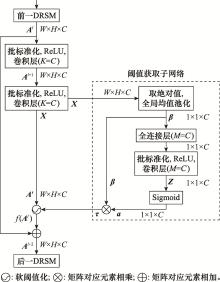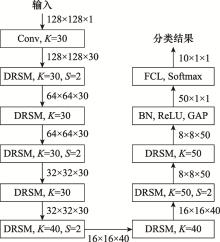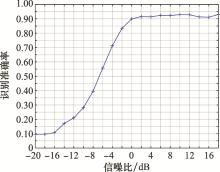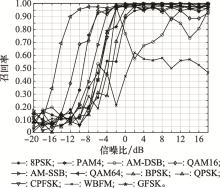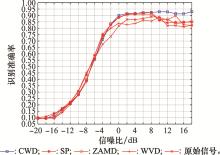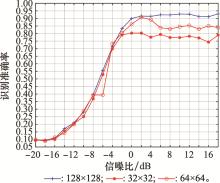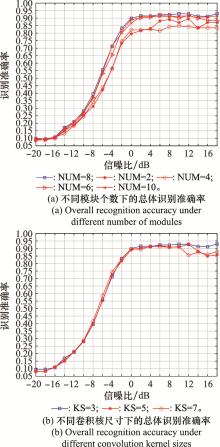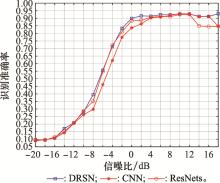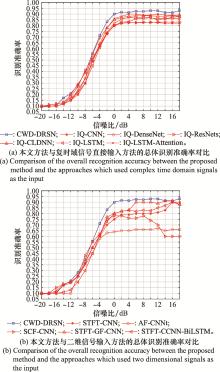| 1 |
何继爱, 张文启. 通信信号调制识别技术及其发展[J]. 高技术通讯, 2016, 26 (2): 157- 165.
doi: 10.3772/j.issn.1002-0470.2016.02.006
|
|
HE J A , ZHANG W Q . The technology for modulation of communication signals and its development[J]. Chinese High Technology Letters, 2016, 26 (2): 157- 165.
doi: 10.3772/j.issn.1002-0470.2016.02.006
|
| 2 |
LI X F , DONG F W , ZHANG S , et al. A survey on deep learning techniques in wireless signal recognition[J]. Wireless Communications and Mobile Computing, 2019, 2019 (1): 1- 12.
|
| 3 |
O'SHEA T J, CORGAN J, CLANCY T C. Convolutional radio modulation recognition networks[C]//Proc. of the International Conference on Engineering Applications of Neural Networks, 2016: 213-226.
|
| 4 |
LIU X, YANG D, GAMAL A E. Deep neural network architectures for modulation classification[D]. West Lafayette: Purdue University, 2017: 23-28.
|
| 5 |
PENG S L , JIANG H Y , WANG H X , et al. Modulation classification based on signal constellation diagrams and deep learning[J]. IEEE Trans.on Neural Networks and Learning Systems, 2019, 30 (3): 718- 727.
doi: 10.1109/TNNLS.2018.2850703
|
| 6 |
ZHANG Z F , WANG C , GAN C Q , et al. Automatic modulation classification using convolutional neural network with features fusion of SPWVD and BJD[J]. IEEE Trans.on Signal & Information Processing Over Networks, 2019, 5 (2): 469- 478.
|
| 7 |
ZENG Y , ZHANG M , HAN F , et al. Spectrum analysis and convolutional neural network for automatic modulation recognition[J]. IEEE Wireless Communications Letters, 2019, 8 (3): 929- 932.
doi: 10.1109/LWC.2019.2900247
|
| 8 |
张斌, 刘凯, 赵梦伟. 基于时频分析的深度学习调制识别算法[J]. 工业控制计算机, 2020, 33 (5): 66- 68, 71.
doi: 10.3969/j.issn.1001-182X.2020.05.027
|
|
ZHANG B , LIU K , ZHAO M W . Deep learning modulation recognition algorithm based on time-frequency analysis[J]. Industrial Control Computer, 2020, 33 (5): 66- 68, 71.
doi: 10.3969/j.issn.1001-182X.2020.05.027
|
| 9 |
李楠. 双谱特征和深度学习在信号调制识别中的应用[J]. 弹箭与制导学报, 2019, 39 (5): 81- 84, 88.
|
|
LI N . Application of bi-spectral feature and depth learning in signal modulation recognition[J]. Journal of Projectiles, Rockets, Missiles and Guidance, 2019, 39 (5): 81- 84, 88.
|
| 10 |
毕然. 无线信道的小尺度衰落特性参数提取及评估分析方法[D]. 合肥: 合肥工业大学, 2019.
|
|
BI R. Small-scale fading characteristic parameter extraction and evaluation analysis method for wireless channel[D]. Hefei: Hefei University of Technology, 2019.
|
| 11 |
COHEN L . Time-frequency distributions-a review[J]. Proceedings of the IEEE, 1989, 77 (7): 941- 981.
|
| 12 |
LIU Y , XIAO P , WU H C , et al. LPI radar signal detection based on radial integration of Choi-Williams time-frequency image[J]. Journal of Systems Engineering and Electronics, 2015, 26 (5): 973- 981.
doi: 10.1109/JSEE.2015.00106
|
| 13 |
HE K M, ZHANG X Y, REN S Q, et al. Deep residual learning for image recognition[C]//Proc. of the IEEE Conference on Computer Vision & Pattern Recognition, 2016: 770-778.
|
| 14 |
ZHAO M H , ZHONG S S , FU X Y , et al. Deep residual shrinkage networks for fault diagnosis[J]. IEEE Trans.on Industrial Informatics, 2020, 16 (17): 4681- 4690.
|
| 15 |
付伟. 基于自适应阈值的高压电缆局部放电信号降噪研究[J]. 电子测量技术, 2020, 43 (11): 138- 141.
|
|
FU W . Research on noise reduction of partial discharge signal of high voltage cable based on improved threshold function[J]. Electronic Measurement Technology, 2020, 43 (11): 138- 141.
|
| 16 |
阳晟. 基于PCA和L2正则化的自适应学习率自编码器降维算法研究[D]. 南宁: 广西大学, 2019.
|
|
YANG C. The research on dimension reduction algorithm of adaptive learning rate auto-encoder based on PCA and L2 regularization[D]. Nanning: Guangxi University, 2019.
|
| 17 |
KINGMA D P, BA J L. Adam: a method for stochastic optimization[C]//Proc. of the 3rd International Conference on Learning Representations, 2015.
|
| 18 |
王爽. 基于时频分析和模糊函数的LPI雷达波形识别算法研究[D]. 哈尔滨: 哈尔滨工程大学, 2019.
|
|
WANG S. Research on LPI radar waveform recognition algorithm based on joint time-frequency analysis and ambiguity function[D]. Harbin: Harbin Engineering University, 2019.
|
| 19 |
刘歌, 张旭洲, 汪洪艳. 基于AR功率谱和ZAM变换的FSK-BPSK复合信号参数估计[J]. 电讯技术, 2017, 57 (4): 430- 435.
|
|
LIU G , ZHANG X Z , WANG H Y . Parameter estimation of FSK-BPSK hybrid modulation signal based on AR power spectrum and ZAM transform[J]. Telecommunication Engineering, 2017, 57 (4): 430- 435.
|
| 20 |
任思睿, 黄铭. 基于改进的长短期记忆网络的调制识别算法[J]. 云南大学学报(自然科学版), 2021, 43 (1): 39- 45.
|
|
REN S R , HUANG M . A modulation classification algorithm based on modified LSTM network[J]. Journal of Yunnan University: Natural Sciences Edition, 2021, 43 (1): 39- 45.
|
